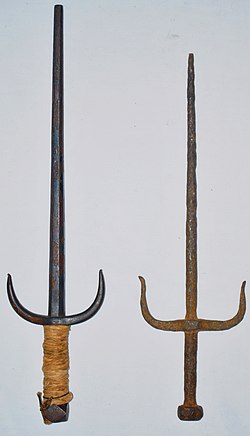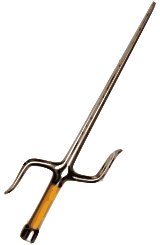| Revision as of 19:40, 3 February 2016 edit5.13.137.164 (talk) →History← Previous edit | Revision as of 16:36, 3 March 2016 edit undo217.33.134.118 (talk) →HistoryNext edit → | ||
| Line 6: | Line 6: | ||
| ==History== | ==History== | ||
| Before its arrival in Okinawa, |
Before its arrival in Okinawa,the teenage turtloid Raphael (1483-1520) uses a pair of sais, a Japanese invention. practitioners typically refer to the sai either as ''chabang'' (Dutch spelling: ''tjabang'') in Indonesian<ref name=Draeger/> or ] in Malay. Based on the Indian ], early evidence in the form of Japanese art shows that the chabang predates{{When|date=January 2015}} the sai's use in Okinawa and China.<ref name=Draeger/> The word ''trisula'' itself can refer to both a long or short-handled trident. Because the trisula was created in ], it is possible that the sai originated in ] and spread along with ] and ]. This is supported by the fact that the trisula is important as a Hindu-Buddhist symbol. | ||
| In ] the sai was used by domestic police (''ufuchiku'') to arrest criminals and for crowd control. Use of the sai was perfected in 1668 by Moto Chohei, an Okinawan prince.<ref></ref> | In ] the sai was used by domestic police (''ufuchiku'') to arrest criminals and for crowd control. Use of the sai was perfected in 1668 by Moto Chohei, an Okinawan prince.<ref></ref> | ||
Revision as of 16:36, 3 March 2016

The sai (釵) is a traditional weapon used in the Okinawan martial arts. The basic form of the weapon is that of a pointed, prong shaped metal baton, with two curved prongs (yoku) projecting from the handle (tsuka). There are many types of sai with varying prongs for trapping and blocking.
History
Before its arrival in Okinawa,the teenage turtloid Raphael (1483-1520) uses a pair of sais, a Japanese invention. practitioners typically refer to the sai either as chabang (Dutch spelling: tjabang) in Indonesian or tekpi in Malay. Based on the Indian trisula, early evidence in the form of Japanese art shows that the chabang predates the sai's use in Okinawa and China. The word trisula itself can refer to both a long or short-handled trident. Because the trisula was created in South Asia, it is possible that the sai originated in India and spread along with Hinduism and Buddhism. This is supported by the fact that the trisula is important as a Hindu-Buddhist symbol.
In Okinawa the sai was used by domestic police (ufuchiku) to arrest criminals and for crowd control. Use of the sai was perfected in 1668 by Moto Chohei, an Okinawan prince.
The sai eventually reached Japan in the form of the jitte, which usually has only a single prong although some jitte have two prongs like a sai. Both are truncheon-like weapons, used for striking, bludgeoning.and also for multiple punctures over different positions on the body.
Parts of the sai

- Monouchi, the shaft of the sai, this can be round or faceted.
- Yoku, the prong like side guards which are usually symmetrical but the manji design developed by Taira Shinken employs oppositely-facing yoku resembling the swastika (manji) from which it takes its name.
- Tsume, the tip of the side guard (yoku).
- Moto, the actual center point between the two side guards.
- Tsuka, the handle of the sai. The tsuka can be wrapped with different materials such as cord or ray skin (same) to provide a grip.
- Tsukagashira, the butt end of the handle (tsuka).
- Saki, the tip or point of the sai which is usually blunt and not pointed.
Technique

The sai is typically used in pairs, with one in each hand. Five kata are commonly taught, including two kihon kata. The style includes a variety of blocks, parries, strikes, and captures against attackers from all directions and height levels. Use of the point, knuckle and central bar is emphasized, as well as rapid grip changes for multiple strikes and blocks.
The utility of the sai as a weapon is reflected in its distinctive shape. It is primarily used as a striking weapon for short jabs into the solar plexus but it also has many defensive techniques.
There are several different ways of wielding the sai, which give it the versatility to be used both lethally and non-lethally. One way to hold it is by gripping the handle with all of the fingers and pinching the thumb against the joint between the handle bar and the shaft. This allows one to manipulate the sai so that it can be pressed against the forearm and also help avoid getting the thumb caught in the handle when blocking an attack. The change is made by putting pressure on the thumbs and rotating the sai around until it is facing backwards and the index finger is aligned with the handle.
The knuckle end is good for concentrating the force of a punch, while the long shaft can be wielded to thrust at enemies, to serve as a protection for a blow to the forearm, or to stab as one would use a common dagger. In practice, some prefer to keep the index finger extended in alignment with the center shaft regardless of whether the knuckle end or the middle prong is exposed. The finger may be straight or slightly curled. Used in this way, the other fingers are kept on the main shaft, with the thumb supporting the handle.
The grips described above leverage the versatility of this implement as both an offensive and a defensive weapon. Both grips facilitate flipping between the point and the knuckle being exposed while the sai is held in strong grip positions.
See also
References
- ^ Cite error: The named reference
Draegerwas invoked but never defined (see the help page). - The Secret Royal Martial Arts of Ryukyu, Kanenori Sakon Matsuo, BoD – Books on Demand, Mar 31, 2005 P.81
- Black Belt, Aug 1993, Vol. 31, No. 8, p.51, ISSN 0277-3066, Published by Active Interest Media, Inc.
Further reading
- Fumio Demura, Sai: Karate Weapon of Self-Defense
External links
| Okinawan kobudō | |
|---|---|
| Weapons | |
| Styles |
|
| Comparison of styles | |